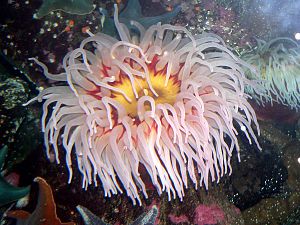Fish-eating sea dahlia
| Fish-eating sea dahlia | ||||||||||||
|---|---|---|---|---|---|---|---|---|---|---|---|---|

Fish-eating sea dahlia ( Urticina piscivora ) |
||||||||||||
| Systematics | ||||||||||||
|
||||||||||||
| Scientific name | ||||||||||||
| Urticina piscivora | ||||||||||||
| Sebens & Laakso , 1978 |
The fish-eating sea dahlia ( Urticina piscivora ) is a sea anemone from the cold, northeastern Pacific on the west coast of North America . It lives there at depths of 1 to 30 meters, attached to rocks or perches .
features
Urticina piscivora is the largest species of the sea dahlia and reaches a diameter of 30 centimeters. Their long tentacles nettle very strongly and stand far outside on the mouth disc, which is drawn with a ray-like yellow-red pattern. The sea dahlia eats fish , but also crabs and other invertebrates .

Commensals
A small fish Oxylebius pictus uses the proximity to Urticina piscivora for protection during the night when the fish are inactive. They swim and rest between the tentacles or near the body column without being injured or trapped by them. However, compared to the related Urticina lofotensis, it is only used as a shelter to a very minor extent (around 2%). Both species offer Oxylebius pictus effective protection against predators. Since both sea anemones are also associated with copepods (Copepoda), they also serve as feeding grounds for Oxylebius pictus , which feeds almost exclusively on copepods. The sea anemone has no discernible benefit from this compound and the fish is referred to as an optional commensal . It is not yet known why Oxylebius pictus is not bothered by the sea anemone.
swell
literature
- Helmut Debelius: Marine Atlas, Volume 1 . 2nd ed., 1215 pages, Mergus-Verlags GmbH, Melle 1997. Google Books
Individual evidence
- ↑ Joel Elliott: The role of sea anemones as refuges and feeding habitats for the temperate fish Oxylebius pictus. Environmental Biology of Fishes, 35 (4): 381-400, 1992. doi: 10.1007 / BF00004991